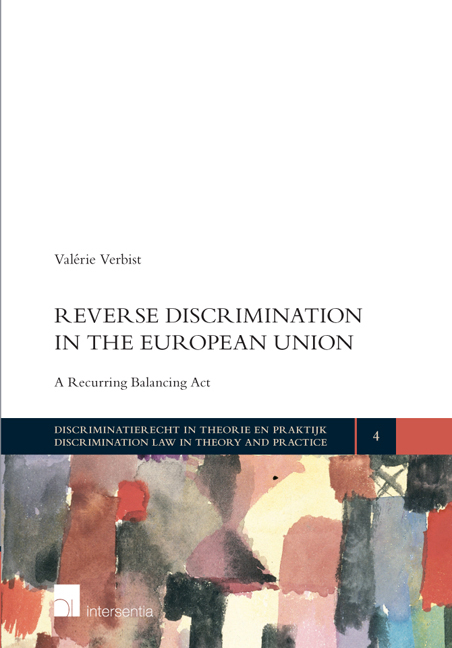Book contents
- Frontmatter
- Acknowledgements
- Contents
- Table of Cases of the European Court of Justice
- Chapter 1 Introduction
- Part I Reverse Discrimination from a Union Perspective
- Chapter 2 The European Court of Justice's Approach to Reverse Discrimination
- Chapter 3 Applicability and Interpretation of the Purely Internal Situation Doctrine
- Conclusion Part I
- Part II Reverse Discrimination from National Perspectives
- Part III Reverse Discrimination in a Federal State Context
- Bibliography
Chapter 2 - The European Court of Justice's Approach to Reverse Discrimination
from Part I - Reverse Discrimination from a Union Perspective
Published online by Cambridge University Press: 29 September 2018
- Frontmatter
- Acknowledgements
- Contents
- Table of Cases of the European Court of Justice
- Chapter 1 Introduction
- Part I Reverse Discrimination from a Union Perspective
- Chapter 2 The European Court of Justice's Approach to Reverse Discrimination
- Chapter 3 Applicability and Interpretation of the Purely Internal Situation Doctrine
- Conclusion Part I
- Part II Reverse Discrimination from National Perspectives
- Part III Reverse Discrimination in a Federal State Context
- Bibliography
Summary
In this chapter, the ECJ's position on reverse discrimination is examined. After a brief explanation of the ECJ's case law establishing the purely internal situations rule, there is analysis of the ECJ's case law according to which reverse discrimination does not fall within the scope of Union law and, hence, is not prohibited by Union law. Since this position has not been unanimously approved of, we will also discuss some proposals which aim to address reverse discrimination at the Union level. Finally, the question of whether the underlying rationale of the ECJ's traditional position on reverse discrimination remains valid will be assessed on the basis of the current Treaties.
ECJ'S TRADITIONAL APPROACH: REVERSE DISCRIMINATION IS NOT PROHIBITED BY UNION LAW
THE EARLY CASE LAW ON PURELY INTERNAL SITUATIONS
The Notion of a ‘Purely Internal Situation’
The Court of Justice used the notion of a ‘purely internal situation’ for the first time in 1979, in the Knoors case. Mr Knoors was a Dutch national residing in Belgium where he had been working as a plumbing contractor. He applied to the Dutch authorities for authorisation to practise the same trade in the Netherlands. However, the Dutch authorities refused his application because he did not possess the necessary qualifications according to the Dutch legislation. They added that Mr Knoors could not be considered a beneficiary of the provisions of Directive 64/427, according to which a Member State has to recognise the actual practice in another Member State as a sufficient proof of the qualifications required. In this context, the question was raised as to whether a national could be considered to be a beneficiary of the Directive towards his own state.
- Type
- Chapter
- Information
- Reverse Discrimination in the European UnionA Recurring Balancing Act, pp. 21 - 46Publisher: IntersentiaPrint publication year: 2017

